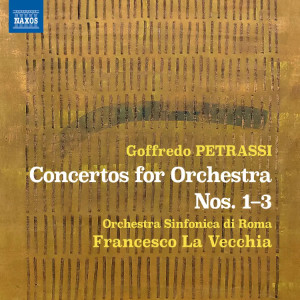
Goffredo Petrassi (1904-2003)
(Primo) Concerto per Orchestra (1933-34)
Secondo Concerto per orchestra (1951)Récréation concertante – Terzo Concerto per orchestra (1952-53)
Orchestra Sinfonica di Roma/Francesco La Vecchia
rec. 2012/13, OSR Studios & Auditorium Conciliazione, Rome
Naxos 8.573702 [61]
Given that it is over a decade since the privately-funded Orchestra Sinfonica di Roma folded, I was slightly surprised to see the Naxos vaults still disgorging new recordings. This is the first of two releases – the second scheduled to follow in just a few months – featuring the Concerti for Orchestra by Goffredo Petrassi. Volume 1 features the first three concerti and is conducted by the orchestra’s artistic and musical director Francesco La Vecchia. The bulk of the orchestra’s recording work was for Naxos – I reckon this is around their 30th release – with the complete orchestral works of Respighi appearing on Brilliant Classics.
My knowledge of the music of Petrassi is limited to a pair of impressive choral and orchestral collections on Chandos conducted by Gianandrea Noseda. Direct comparison of the recordings and the execution between those discs and this one, albeit of very different genres of music, reveals my abiding concern with performances by these artists. Simply put they are acceptable without being top drawer technically or musically. In the past, wherever alternatives by more famous ensembles exist, I have found the Orchestra Sinfonica di Roma to lack individual and collective brilliance and the performances to feel a rehearsal or two short of the confidence and insights that time alone can bring. This is certainly true of their surveys of Martucci, Respighi or Casella to name but three.
Even without knowing a note of these scores previously, the very opening of the Primo Concerto per Orchestra highlights concerns of ensemble and unanimity of attack. According to the liner note, after the success in 1932 of his Partita, this work, begun in 1933 but not premiered until 1935, secured his reputation. In three movements that last here 28:46 this is a very consciously gnarly neo-classical score. The closest immediate comparison that struck me was the angular muscular writing of Albert Roussel whose most famous neo-classical scores predate this work by a handful of years – I wonder how familiar Petrassi was with his French counterpart? The liner suggests Stravinsky and Hindemith as other influences but I hear that as more common shared musical gestures within the neo-classical genre rather than specific stylistic imitation. The title of concerto for orchestra is well-deserved in that Petrassi deploys the full instrumentation – including a significant part for piano and an alto saxophone too – demandingly. A bustling allegro and equally dynamic closing Tempo di Marcia frame a central adagio which I found the most interesting in terms of instrumental textures and effects. These types of scores benefit from razor-sharp textures and ensemble and a careful handling of the instrumental textures. The strings of the orchestra, as recorded, are a little edgy and too often there seems little care given to the blending or balancing of textures across the orchestra so instrumental lines overwhelm others with no coherence or continuity of musical goals.
The Secondo Concerto per orchestra was not written for another seventeen years and was premiered in early 1952 by Paul Sacher and his Basler Kammerorchester – the ensemble who had premiered Honegger’s Symphony No.4 about eight years earlier. Petrassi’s work is considerably more compact than the first essay – four continuous movements lasting just 17:09. The 1950’s saw the bulk of Petrassi’s concerti – he completed Nos.2-6 during this decade which also saw him embrace the Post-War modernist and avant-garde styles that came to dominate contemporary music. For the listener this means a move towards musical lines with less clearly defined tonal anchors. The upper strings again struggle with this resulting in a somewhat ‘smeary’ sound where pitch centres often fail to convince – again something more rehearsal would probably have solved since these are competent players. The etiolated string tone is unattractive even if Petrassi requests “senza vib.” which it sounds if it might be the case. The closing Presto is just scrappy.
The liner suggests that the Terzo Concerto per orchestra – Récréation concertante written just a year later is “animated and playful”. I am not sure I hear much that is playful which as a description would suggest to me something lighter in spirit than the rather terse and serious earlier works. Here there are five continuously played movements lasting a compact 20:46. The scoring is heavier with a percussion section making its first significant presence felt. Again slack ensemble really undermines the power of the work with all sections of the orchestra impacted. To be fair this is not awful but such is the base-line standard of orchestral playing today that anything except precision sounds shoddy and in music such as this that is especially detrimental. Casting around on discogs for information about other performances it appears that by timings alone these are slower than some other versions which may add to the slightly laboured feel.
The companion disc is due for release later this year. Not something I will be seeking out.
Nick Barnard
Buying this recording via a link below generates revenue for MWI, which helps the site remain free




















